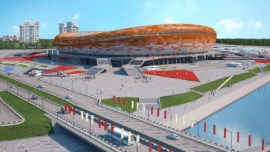
by Brianna Crandall — August 22, 2014—As the excitement of the 2014 World Cup in Brazil drew to a close and attention turned to the competition in four years’ time that will take place in Russia, the U.K.-based built environment consultancy BRE (Building Research Establishment) announced that six of the new stadiums that will be constructed for the tournament are being assessed under the BRE Environmental Assessment Method (BREEAM) to help drive the sustainable design and construction of the venues and provide international recognition for their achievement.
Ksenia Agapova, Associate Director at Jones Lang Lasalle (JLL) in Moscow, is acting as BREEAM advisor on three projects—the stadiums at Samara, Volgograd and Nizhniy Novgorod.
“The World Cup 2018 stadiums, designed to BREEAM standards, will raise the bar of sustainable design and construction in Russia,” she says. “Regulations in green building are not well developed here, and few incentives exist for implementation of green technologies. It is a significant achievement for the design team to receive this international recognition and prove compliance with highest international standards. We are looking forward to successful completion of these projects and expected increased public awareness of green building, as these venues attract a lot of attention.”
During the preparation of the design briefs for the stadiums, a series of consultations were undertaken with representatives from the local communities, business groups, football clubs, the organizing committee and local authorities. Experience from the construction of other sports venues was applied in the form of design guidance from FIFA (Fédération Internationale de Football Association), as well as learning from similar projects around the world. Information about the project and construction process is published on a regular basis online and is publically available through a knowledge-sharing platform to ensure knowledge transfer from one project to another.
According to BRE, sustainable features of the stadium designs include:
- Highly energy-efficient lighting designed to achieve international best practice standards for light quality, with automated lighting controls to reduce energy bills;
- Overall energy consumption of 40 percent less than a comparable baseline building, with savings achieved through reduced building fabric U-values, efficient heating with heat recovery, and efficient ventilation with CO2 sensors in premises when unpredictable occupancy patterns can occur;
- Facilities for segregated waste collection including organic waste storage and packaging, together with a compactor;
- All restrooms equipped with water-saving fixtures and valves to prevent uncontrollable water leakage, which is very common for large venues;
- Public transport information points to help visitors travel more sustainably, with site layouts designed to prevent the intersection of pedestrian, parking and delivery pathways; and
- Ecological and biodiversity studies that go above typical local construction practice requirements, with measures to enhance local biodiversity.
According to BRE, BREEAM has previously been used extensively in the sporting field, including the Olympic venues for the London 2012 games and a range of other sports stadiums around the world.





